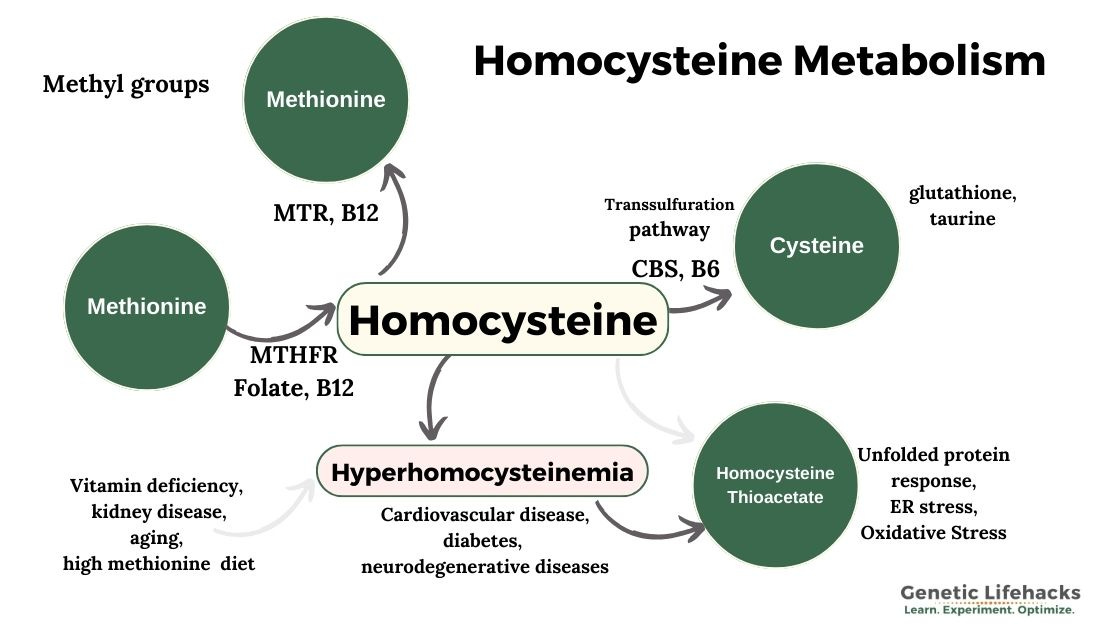Homocysteine is more than just MTHFR
Preventing the diseases of aging by reducing homocysteine levels
Hi everyone,
This week's new article is one that has been a long time coming. I had read (and written) many times about how the MTHFR genetic variants increase the risk of high homocysteine levels. This is usually followed by an explanation that high homocysteine is an important marker for heart disease risk. Most articles, including my MTHFR article, are kind of nebulous about why high homocysteine is a problem. Turns out there is a lot more to the story...
My new article (below) delves into what homocysteine is -- and how higher levels may play a causal role in heart disease, diabetes, NAFLD, metabolic syndrome, and Alzheimer's.
Homocysteine levels rise as we age, and some researchers think that keeping homocysteine levels low is a key factor in healthspan.[ref]
Fortunately, there are several natural ways to lower homocysteine levels, and understanding your genetic variants can point you to the best path.
Looking ahead:
As summer winds down, I plan to work on behind-the-scenes improvements to enhance the member experience. Yes, I've been sneaking away this summer to camp, hike, and enjoy the Montana mountains. In doing so, I've been using the mobile version of the site more and more (envision tent camping in the rain with a cell phone on a mountaintop :-). So... improvements to the mobile site are now in the works, as well as other upgrades.
Wishing you all health and happiness,
Debbie
Word of mouth is the best way that people find out about Genetic Lifehacks. This type of recommendation means so much to me!
If you enjoy the site, would you consider telling someone about it this week?
New article -- open to non-members this week only.
Understanding Homocysteine Levels: Genetics and Solutions
Key takeaways:
~ Research shows that high homocysteine levels can cause excess oxidative stress and endoplasmic reticulum stress.
~ Epidemiologic studies show that high homocysteine levels are strongly linked to an increased relative risk of cardiovascular diseases.
~ Homocysteine is an intermediate produced in the methionine cycle and can be remethylated to methionine or converted to cysteine.
~ Genetic variants in several pathways interact with what you eat (or don’t eat) to increase homocysteine levels.
Let’s dig into how homocysteine is formed and what high homocysteine can mean for your health.
What is homocysteine?
Homocysteine is a sulfur-containing amino acid that is a byproduct of the metabolism of methionine.
What’s methionine? Methionine is an essential amino acid that we get from protein-rich foods. Essential means that it is an amino acid that we have to get from foods, and it is needed for the production of proteins in the body.
Methionine is used by cells to supply methyl groups, which are required in many different cellular reactions. In the methionine cycle, methionine receives adenosine from ATP, which then creates SAM-e (s-adenosyl-methionine). SAM-e can then transfer a methyl group for methylation reactions. When SAM-e loses a methyl group, it becomes SAH (s-adenosyl-homocysteine), which then is hydrolyzed to form homocysteine.[ref]
Homocysteine can then be converted back to methionine or transformed in other pathways.
Why are methyl groups so important? Methyl groups are used in cells in a variety of ways. They are essential in the conversion of serotonin to melatonin and the creation of creatine and phosphatidylcholine. Methyl groups are also used to make neurotransmitters, to silence genes, and to detoxify certain toxins.
When any of these pathways are blocked, homocysteine levels can rise, which causes negative long-term health effects.
How are homocysteine levels maintained?
Homocysteine is constantly being formed and converted. These are ongoing cycles that are constantly happening in your cells, and homocysteine levels are regulated by the cells to maintain a fairly consistent level.
The level of homocysteine depends on the amount that is formed in the conversion of SAMe and SAH (S-adenosyl homocysteine) and the amount that is recycled or further broken down.
In cells, homocysteine is metabolized in three ways:[ref]
It can be remethylated to form methionine (requires folate and vitamin B12 – or needs betaine, BHMT gene)
Can be converted to cysteine (serine and B6 as a cofactor), which is used in the synthesis of glutathione
It can be converted to homocysteine thiolactone, which can be a problem at higher levels
What I've been reading:
This randomized clinical trial compared saffron extract to methylphenidate (Ritalin, Concerta, etc) in children with ADHD. This trial followed successful trials in adults and adolescents, all of which showed that saffron extract (30-40mg/day) was as effective as methylphenidate for ADHD symptoms.
Read more about ADHD and genetics here.
2. S-adenosyl-L-homocysteine extends lifespan through methionine restriction effects
This is an interesting animal study on longevity. Researchers have known for some time that methionine restriction extends lifespan similar to calorie restriction. This study used S-adenosyl-L-homocysteine (SAH) to alter the balance in the methionine cycle. Essentially, increasing SAH causes cells to use methionine to produce SAMe, lowering methionine levels similar to methionine restriction. While this was only an animal study, it shows an interesting link between longevity and the methionine cycle.





